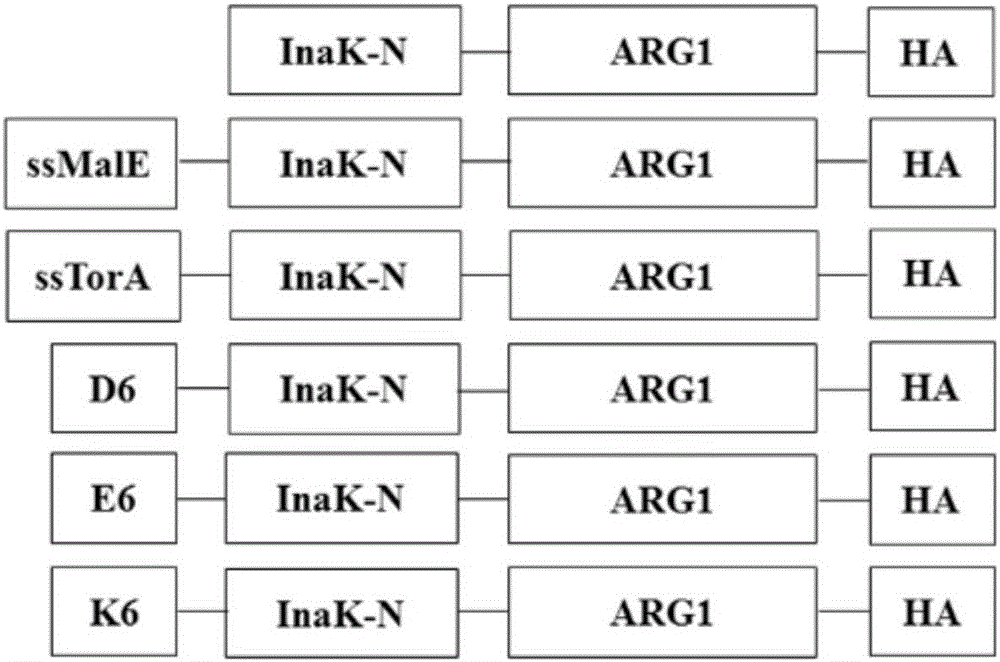Method for immobilizing human source arginase-1 through surface display
A technology for arginase and surface display, which is applied in the field of immobilization of human arginase-1, can solve problems such as ineffective realization of surface display and immobilization of multimeric proteins, so as to improve display efficiency and increase Enzyme activity and the effect of shortening the process flow
- Summary
- Abstract
- Description
- Claims
- Application Information
AI Technical Summary
Problems solved by technology
Method used
Image
Examples
Embodiment 1
[0031]The method of the present invention is used to display human arginase-1 in Escherichia coli. First, the constructed recombinant plasmid containing InaK-N / ARG1 was transformed into Escherichia coli competent cell RosettaBlue strain, and cultured overnight at 37°C. Then, pick a single colony and inoculate it in 100mL of LB medium. The final concentration of the antibiotic ampicillin is 50 μg / mL. Shake culture at 37°C. The OD value is between 0.5 and 0.6. 8 hours. Then, the cells were collected by centrifugation at 12000 RPM at 4°C, washed twice with pre-cooled PBS to remove the residual medium, and finally resuspended in 10 mL of pre-cooled PBS buffer for later use. Then it was measured by Chinard reaction and converted to the corresponding human arginase-1 enzyme activity. ( image 3 , Figure 4 )
Embodiment 2
[0033] The method of the present invention is used to display human arginase-1 in Escherichia coli. First, the constructed recombinant plasmid containing ssMalE-InaK-N / ARG1 was transformed into Escherichia coli competent cell RosettaBlue strain, and cultured overnight at 37°C. Then, pick a single colony and inoculate it in 100mL of LB medium. The final concentration of the antibiotic ampicillin is 50 μg / mL. Shake culture at 37°C. The OD value is between 0.5 and 0.6. 8 hours. Then, the cells were collected by centrifugation at 12000 RPM at 4°C, washed twice with pre-cooled PBS to remove the residual medium, and finally resuspended in 10 mL of pre-cooled PBS buffer for later use. Then it was measured by Chinard reaction and converted to the corresponding human arginase-1 enzyme activity. ( image 3 , Figure 4 )
Embodiment 3
[0035] The method of the present invention is used to display human arginase-1 in Escherichia coli. First, the constructed recombinant plasmid containing ssTorA-InaK-N / ARG1 was transformed into Escherichia coli competent cell RosettaBlue strain, and cultured overnight at 37°C. Then, pick a single colony and inoculate it in 100mL of LB medium. The final concentration of the antibiotic ampicillin is 50 μg / mL. Shake culture at 37°C. The OD value is between 0.5 and 0.6. 8 hours. Then, the cells were collected by centrifugation at 12000 RPM at 4°C, washed twice with pre-cooled PBS to remove the residual medium, and finally resuspended in 10 mL of pre-cooled PBS buffer for later use. Then it was measured by Chinard reaction and converted to the corresponding human arginase-1 enzyme activity. ( image 3 , Figure 4 )
PUM
 Login to View More
Login to View More Abstract
Description
Claims
Application Information
 Login to View More
Login to View More - R&D
- Intellectual Property
- Life Sciences
- Materials
- Tech Scout
- Unparalleled Data Quality
- Higher Quality Content
- 60% Fewer Hallucinations
Browse by: Latest US Patents, China's latest patents, Technical Efficacy Thesaurus, Application Domain, Technology Topic, Popular Technical Reports.
© 2025 PatSnap. All rights reserved.Legal|Privacy policy|Modern Slavery Act Transparency Statement|Sitemap|About US| Contact US: help@patsnap.com



